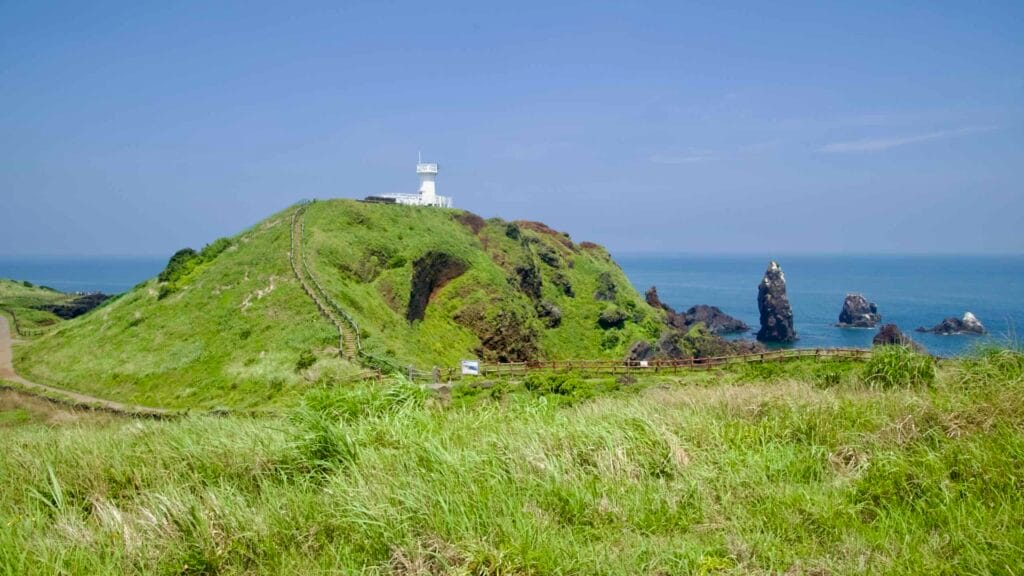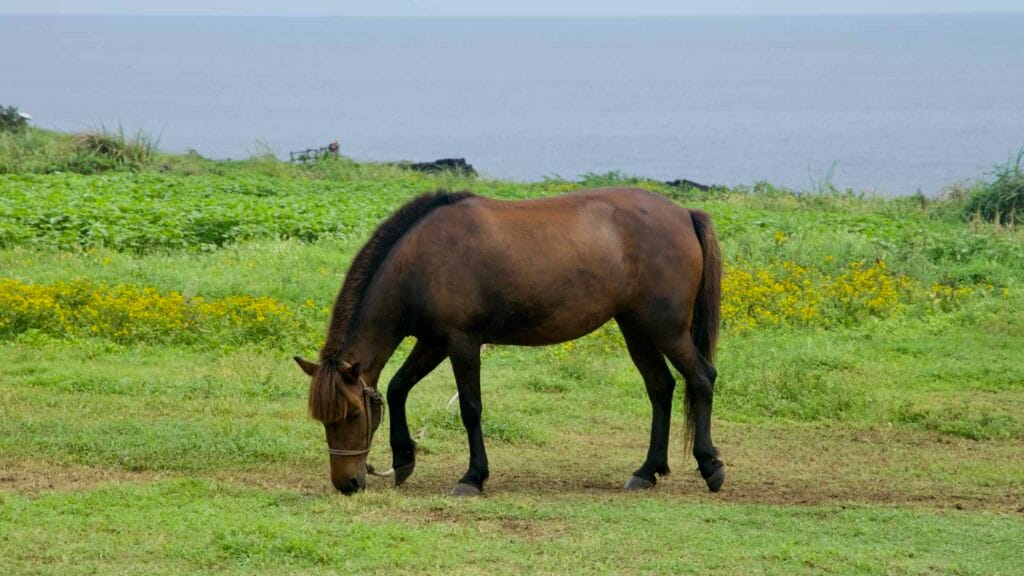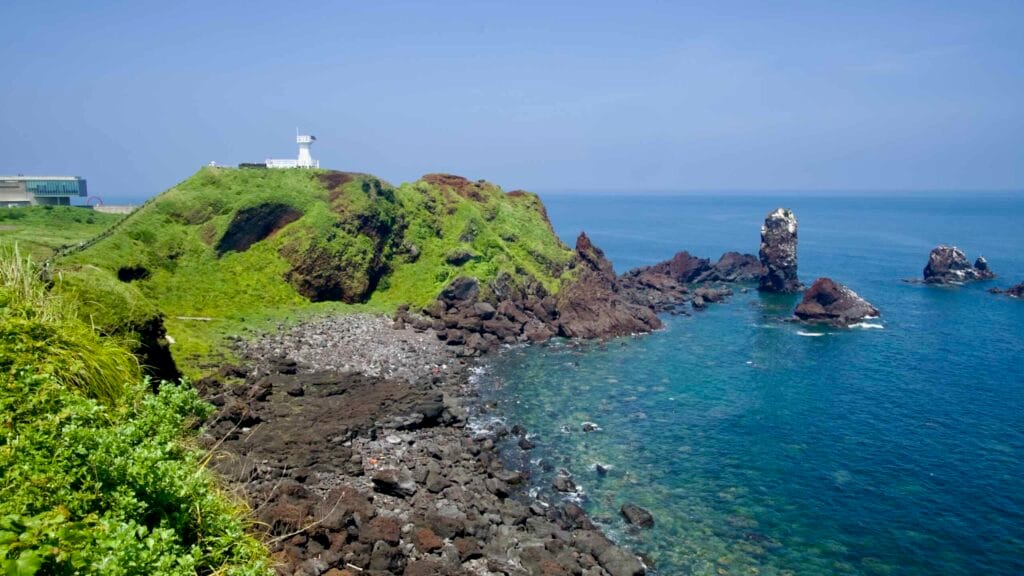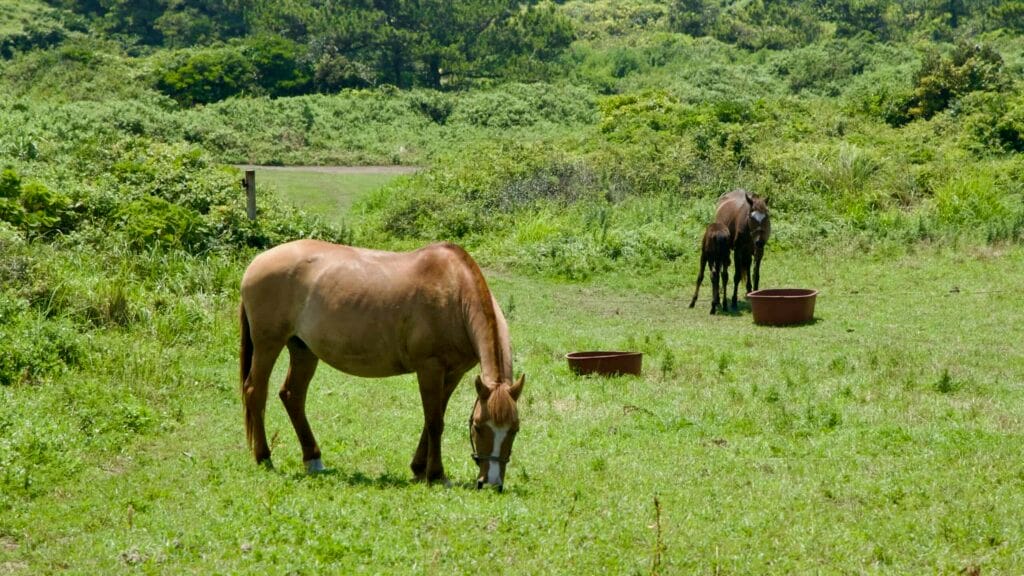Seopjikoji Coast
The Seopjikoji Coast (섭지코지; map) is a peninsula that juts out from Seogwipo City’s eastern shore on Jeju Island. Shaped like a diamond, it lies just south of Seongsan Ilchulbong (Sunrise Peak), giving visitors one of the clearest views of this UNESCO World Heritage Site.
Beyond its vantage point of Sunrise Peak, Seopjikoji holds its own set of attractions. Volcanic cliffs, a red-soil oreum, and open grasslands define the landscape. A lighthouse, beacon fire station, and modern resort complex add human-made features to the natural setting. Wild horses are sometimes seen grazing on the fields, a reminder of the cape’s rural past.
Geography
The name Seopjikoji comes from the Jeju dialect: Seopji meaning “narrow land” and Koji meaning “cape.” Its volcanic origins are evident in the red scoria soil, jagged coastline, and rough cliffs that edge the peninsula.
Seopjikoji was once a separate island, later connected to Jeju by natural sandbars formed over centuries. The site is often described as an outdoor geology museum, displaying layers of volcanic history shaped by wind, waves, and lava. At low tide, the rocky formations stand out more clearly, creating the look of a natural sculpture garden.
Key Features
Let’s tour some of the Seopjikoji Coast’s features.
Standing Rock
Known as “Standing Rock,” Seon Rock (선돌바위; map), or Seonbawi, is solitary volcanic neck that rises roughly 10 meters from the water just off Seopjikoji’s southeast coast.
Seon Rock’s solidified magma once filled a vent in the Bulgeun Oreum cone. But the surrounding softer material eroded away, leaving the “standing” pillar.
Local lore says a dragon king’s youngest son turned to stone while waiting to marry a heavenly maiden.
The rock and nearby rocky coastline are best seen during low tide. You can view them directly from Seopjikoji Coast’s walking paths.
Bulgeun Oreum Volcanic Cone
The Seopjikii Coast sits on the Bulgeun (Red) Oreum Volcanic Cone. Now covered in grassland, this coastal formation was created by Strombolian-style eruptions. Over the years, it has been eroded by sea waves, which exposed red scoria and cut faces its its outer edges.
A short climb leads to its peak, where you’ll find the Seopjikoji Lighthouse, which functions as a navigational beacon and a vantage point with panoramic views of Seongsan Ilchulbong, the offshore swells, and the surrounding Jeju coastline.
Seopjikoji Lighthouse
Perched at the tip of the Bulgeun Oreum Volcanic Cone on the eastern coast, Seopjikoji Lighthouse (방두포등대; map) is an active coastal lighthouse. Its octagonal white concrete tower flashes every 4 seconds, warning passing vessels of the coast’s rocky outcrops.
Visitors can visit the lighthouse via a stair-assisted walking path from the coastal trail. While you can’t climb up the lighthouse, the views from its base of the coastline are spectacular.
The lighthouse was recognized by Korea’s Ministry of Oceans and Fisheries as “Lighthouse of the Month” in April 2019, and is locally nicknamed the “Wish Lighthouse.”
Beacon Fire Station
A short distance from the lighthouse sits a well-preserved stone beacon fire station (봉수대). Dating back to the Joseon Dynasty, this structure (often referenced as Hyeopja Yeondae), measures 4 meters in height and 9 meters across.
The beacon was part of the fire-and-smoke signaling chain that lined the coast and relayed messages across great distances by lighting fires or sending smoke signals, alerting local communities and military forces of invasions or emergencies. Seokjikoji’s beacon relayed signals with nearby posts at Osopo and Seongsan to the north and Maldungpo to the west.
Aqua Planet Jeju
Aqua Planet Jeju (아쿠아플라넷 제주; map) sits on the narrow neck leading to Seopjikoji Coast. Opened 2012, it holds around 10,800 tons of saltwater for its sea critters. The main tank (“Sea of Jeju”) holds about 5.3 million liters with around 500 species and 48,000 animals.
The aquarium is divided into three zones: Aquarium (cold- and warm-water exhibits with tunnel viewing), Marine Science Hall, and Ocean Arena, where visitors can watch a live aquabatics show with high divers and a story about local haenyo divers.
Species lists change, but always include large sand tiger sharks, rays and schools of fish. Smaller galleries house penguins, otters, and reef species.
Seongsan Ilchulbong
Three kilometers north of Seopjikoji Coast lies Seongsan Ilchulbong or Sunrise Peak. This UNESCO-listed tuff cone stands 182 meters tall and was formed 5,000 to 6,700 years ago by phreatomagmatic eruptions in shallow water.
The cone was originally offshore, but coastal sandbars later connected it to Jeju Island. The crater rim encircles a bowl 600 meters across.
Seongsan Ilchulbong was listed as a Natural Monument of Korea in 2000 and is part of the “Jeju Volcanic Island and Lava Tubes” World Natural Heritage (2007), and Global Geopark (2010).
Climbing Seongsan Ilchulbong is possible after purchasing tickets. The trek includes a 20 to 30 minute hike on stone and wooden deck staircases to its summit. Vows include the volcano’s inner depression, Udo Island, Hallasan, and the east coast.
Horses of Seopjikoji
Travel around Seopjikoji and you’ll find several Jeju ponies. The cape’s open grasslands are used for managed grazing, and the nearby Steel Flower Horse Riding Ranch runs guided coastal rides using these horses.
These are Jeju’s native horses, designated Natural Monument No. 347 in 1986. A short and sturdy horse, the breed’s characteristics include blocky bodies and thick necks, high cold-tolerance, and hard hooves that often don’t need shoes. They worked fields and hauled loads on Jeju’s basalt terrain for centuries.
After mechanization and crossbreeding reduced purebred numbers, pedigree registration and preservation racing at the Jeju Racecourse helped stabilize the population.
Jeju is also a designated Horse Industry Special Zone, so equestrian programs and riding experiences are promoted island-wide.
Phoenix Island
Phoenix Island (휘닉스 제주 섭지코지; map) is a resort complex spread across the Seopjikoji headland. It is organized around three condominium wings (A/B/C) and the Hillius villa zone.
Facilities include year-round indoor and outdoor pools, a sauna, and a treatment spa, with family amenities including a Kids Play Lounge and Game zones.
The resort also includes cultural buildings and coastal trails, including Yumin Art Nouveau Museum, Glass House, and Agora.
Glass House
Glass House (글라스하우스; map) is concrete-and-glass cantilevered building designed by famous architect Tadao Ando. It sits over the northeastern sloped Seopjikoji.
Today it functions as a visitor pavilion with a restaurant (Mint), cafe and event/gallery. Its position offers panoramic views across Seopjikoji and an unobstructed angle on Seongsan Ilchulbong.
Yumin Art Nouveau Museum
Yumin Art Nouveau Museum (유민 아르누보 뮤지엄; map) sits near Glass House on Seopjikoji Coast’s northwestern reaches. It houses an Art Nouveau glass curated by JAC Studios in Denmark and housed in a building designed by Mario Botta in 2017.
The collection centers on late-19th/early-20th-century French glass, with representative works by Émile Gallé and the Daum brothers, among others. The museum provides multilingual brochures and fixed-time tours.
Seasonal Highlights
Seopjikoji transforms throughout the year, offering visitors a chance to experience its beauty in different ways:
- Spring: Fields of vibrant yellow canola flowers blanket the landscape, contrasting beautifully with the azure sea and red volcanic soil. This is one of the most photogenic times to visit, with the cape drawing photographers and nature enthusiasts alike.
- Summer: The sunshine and clear skies enhance the colors of Seopjikoji’s cliffs, ocean, and flora. This season is ideal for exploring the coastal trails and enjoying the refreshing sea breeze.
- Autumn: Waves of silver grass sway gently in the wind, covering the landscape with an ethereal beauty. The golden hues of the grass against the deep blue ocean make autumn a favorite season for scenic walks.
- Winter: The stark beauty of Seopjikoji in winter offers a quieter, more serene experience. The rugged cliffs and lighthouse stand out against the dramatic waves and crisp air.
Cultural Significance
Seopjikoji holds a special place in Korean pop culture. It has been featured in numerous dramas and films, most notably All In (올인; 2003), a hit TV series that brought the cape into the national spotlight. The All In House, originally built as a filming set, was later repurposed as a tourist attraction.
Though its use has changed over the years, it remains a nostalgic draw for fans of the show. This connection between nature and popular culture has helped establish Seopjikoji as a destination beloved by both locals and international visitors.
Exploring Seopjikoji
The main walking path, approximately 1.5 hours in length (map), winds through Seopjikoji’s most iconic features, including canola fields, volcanic cliffs, and historical landmarks. The trail culminates at the lighthouse atop Bulgeun Oreum. While the path is relatively flat and accessible, sturdy walking shoes are recommended due to sections of uneven terrain.
Visiting Information
- Entrance Fee: Free
- Parking Fee: 1,000 KRW for the first 30 minutes, 500 KRW for each additional 15 minutes (maximum 3,000 KRW).
- Operating Hours: Open year-round, no restrictions on entry times.
- Accessibility: Easily reachable by car, with ample parking available. The nearest public transport stops at Seongsan Ilchulbong, followed by a short taxi ride.



























































